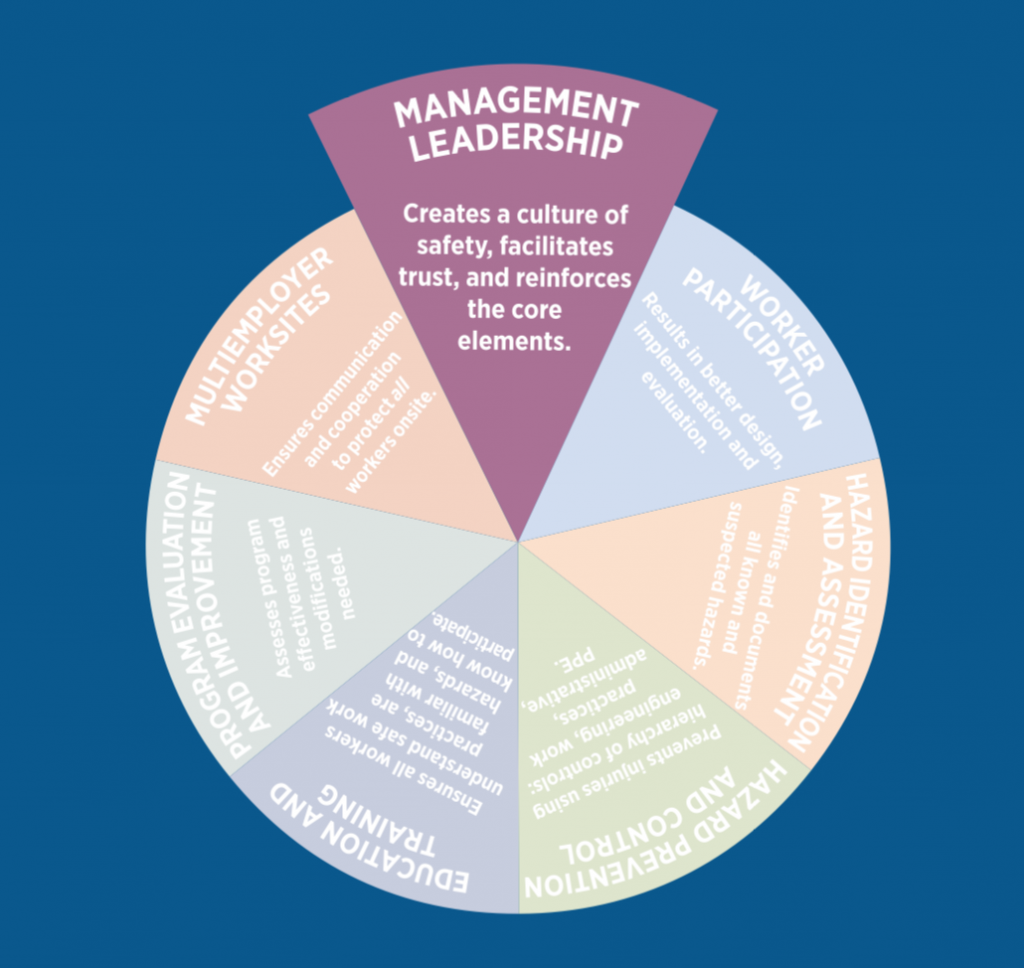 Why are health and safety important in the workplace? At the end of the day, there are three important reasons why organizations should care about health and safety: it’s regulated, it will cost all companies time and resources either for preventative measures or reactionary measures that impact their brand and the people, and finally, it protects the team. In Canada, specifically Ontario, this is crucial. As a manager, protecting your team means serving customers well because when companies take care of their team they take care of their customers. Globally, Canada is leading the way on some health and safety best practices, and we can also learn from some countries like Singapore and the UK. A safer working environment requires everyone to be on board. Protect yourself, your workers, and your reputation. Contact the experts at ACUTE today to learn more about safe work practices for your entire team!
Why are health and safety important in the workplace? At the end of the day, there are three important reasons why organizations should care about health and safety: it’s regulated, it will cost all companies time and resources either for preventative measures or reactionary measures that impact their brand and the people, and finally, it protects the team. In Canada, specifically Ontario, this is crucial. As a manager, protecting your team means serving customers well because when companies take care of their team they take care of their customers. Globally, Canada is leading the way on some health and safety best practices, and we can also learn from some countries like Singapore and the UK. A safer working environment requires everyone to be on board. Protect yourself, your workers, and your reputation. Contact the experts at ACUTE today to learn more about safe work practices for your entire team!
Interested in ACUTE Health and Safety Courses?

Health and Safety Practices in the Workplace
A great workplace is one where all employees:
1. Achieve organizational objectives
2. Give their personal best
3. Work together as a team/ family in an environment of trust
4. Create a “one culture”
According to a fortune.com article called “What Makes a Workplace a Great Place?,” a “one culture” is one where organizations take in talented people, mold their identities, and assimilate them into their organization’s way of life. A successful workplace includes fulfilling a mandate and vision while retaining great employees. Protecting people through health and safety is a way that companies can safeguard their vision and mandate while retaining their employees.
 Health and Safety is Heavily Regulated
Health and Safety is Heavily Regulated
Why are health and safety important in the workplace? In Canada, specifically Ontario, Health and Safety is heavily regulated. Under the OHSA, employers are required to post a copy of The Health & Safety at Work: “Prevention Starts Here” poster in the workplace. There are also other required documents that must be posted in every workplace. Click here to see the list on the Ontario Ministry of Labour, Immigration, Training and Skills Development’s website. Check out your health and safety awareness by taking this quick quiz here.
Employers in Ontario are also required to have a copy of The Green Book. The Green Book contains laws and regulations for occupations from teachers to farmers to healthcare workers to construction workers. Employers are obligated to post a copy of the Green Book in their workplace and must keep track of revision dates and ensure they have the latest version available. If you are an employer, read what you should know about the 2017 OHSA Green Book here.
Under the OHSA (Occupational Health and Safety Act), employer duties include:
• “Taking all reasonable precautions to protect the health and safety of workers;
• Ensuring that equipment, materials and protective equipment are maintained in good condition;
• Providing information, instruction, and supervision to protect worker health and safety”
Employees have duties under the OHSA too. Reporting any hazards to supervisors and wearing proper protective equipment are just some of the employee responsibilities outlined by the OHSA. Ensuring workers are ready to learn, want to actively participate in safety training, and are willing to perform their duties under the OHSA will help make any workplace a safer place to be!
4 Global Best Practices
1. Management Leadership
One of the best health and safety practices is that of management leadership. Out of the United States, this practice is built on the premise that managers set the leadership, vision, and resources needed for all employees to have an effective health and safety program. Managers set the tone and lead the way for the rest of the organization. This requires managers to take four steps.
 Infographic Source
Infographic Source
– Communicate your commitment to a health and safety program. Always including a written policy, including how to accomplish the goals, is key. Communicate how the policy will affect every level of employees, contractors, subcontractors, visitors, and customers.
– Define program goals. By establishing specific goals and objectives, managers set the tone for the overall effectiveness of the program. Set measurable goals and outline how to realistically accomplish your goals for improving health and safety.
– Allocate resources. Create plans to achieve the goals by assigning tasks and responsibilities to different people, while setting timeframes and determining resources needed. One example is to ensure that safety equipment costs are included in your annual budget.
– Expect performance. Since management is leading the program and establishing roles, responsibilities and guidelines, it can be expected that the health and safety practices will be executed. Provide positive recognition for meeting and exceeding safety and health goals and preventing injury and illness.
 2. Get Employee Input
2. Get Employee Input
If you want to run an effective health and safety program, get your employees involved. Ask for their input in identifying defects in equipment and avoiding injuries. In an office environment, employees should be encouraged to watch their posture. In a manufacturing setting, internal “safety blitzes” can be an effective way of systematically reviewing safety regulations concerning the use of equipment, forklifts, and other machinery. Once input is gathered from employees it is always a good idea to create a reference manual and host a meeting with employees. Make sure that everyone knows safety and security measures.
 3. Director Competence
3. Director Competence
All directors need to have a clear understanding of the key occupational health and safety (OHS) issues for their business and be continually developing their skills and knowledge. The majority of directors have a clear view of where their OHS performance is in relation to other businesses and understand the need to value and emphasize improved levels of OHS performance. The board of directors should be willing to debate key OHS matters for the business and to developing their skills and knowledge of these key issues through training, seminars, etc. It is also helpful for directors to have a clear view of where their OHS performance sits in relation to their peers/others and understand the need for strict controls to maintain current or improved levels of performance. In the UK this is a key best practice.
 3. Preventing Violence
3. Preventing Violence
Violence is defined by the World Health Organization (2004) as “the intentional use of physical force or power, threatened or actual, against oneself, another person, or against a group or community, that either results in or has a high likelihood of resulting in injury, death, psychological harm, maldevelopment, or deprivation.” This includes neglect and all types of physical, sexual, and psychological abuse, as well as suicide and other self-abusive acts. By implementing programs to prevent violence, it is possible to reduce the long-term effects associated with it. In Canada, health and OHS is committed to preventing violence of any kind in the workplace.
 4. Singapore: Vision Zero
4. Singapore: Vision Zero
The concept of Vision Zero comes from Singapore and is a mindset where we recognize that all injuries and ill health outcomes at work are preventable. It is easy to think that having 99.9 percent risk-free operations is acceptable. But with the global workforce numbering 3.4 billion, that would still mean 3.4 million workplace deaths annually – obviously unacceptable. Aiming for vision zero is about instilling a safety and health-first mindset in all stakeholders. This initiative is aimed at zero falls and workplace fatalities.
 Stay Safe at Work With ACUTE!
Stay Safe at Work With ACUTE!
Hands-on, practical consulting is the best way to keep employers and workers safe in the workplace! ACUTE is dedicated to workplace safety and understands the importance of disarming hostile situations. If you have questions about the legislation and how this will impact your workplace, get in touch with ACUTE today. Why get workplace safety training with ACUTE? Here are just some of the benefits of working with ACUTE.

- Open Door Instructor-Student Partnership – ACUTE’s training services emphasize client participation. Staff foster relationships with clients and serve as a touchstone for advice anytime moving forward.
- Serving Your Team and Industry – With a vast array of clients in manufacturing, construction, health, academic, and government sectors, ACUTE brings the best safety practices from across the spectrum to your workplace.
- 100 Years Combined Experience – ACUTE provides comprehensive health and safety training, on-site safety services, and consulting services. With over 100 years of combined experience, our company staff offer more than theoretical or abstract ideas. ACUTE offers solutions.
- Track Record of Success – ACUTE is rated 4.9/5 stars on Google reviews, demonstrating a commitment to our clients, quality, and passion for training.
“We have relied on ACUTE for years to train our staff and
keep them safe on the job site.”
– Bob, Millwrighting Company – Read More Testimonials Here!
Click here to see what training courses we have at ACUTE or contact us today for quality training in your workplace or on-site at ACUTE’s proven training facilities!
ACUTE is located in Waterloo, Ontario, and services customers from cities such as Toronto, Mississauga, Brampton, Hamilton, Milton, Kitchener, London, Guelph, and others across Ontario.

